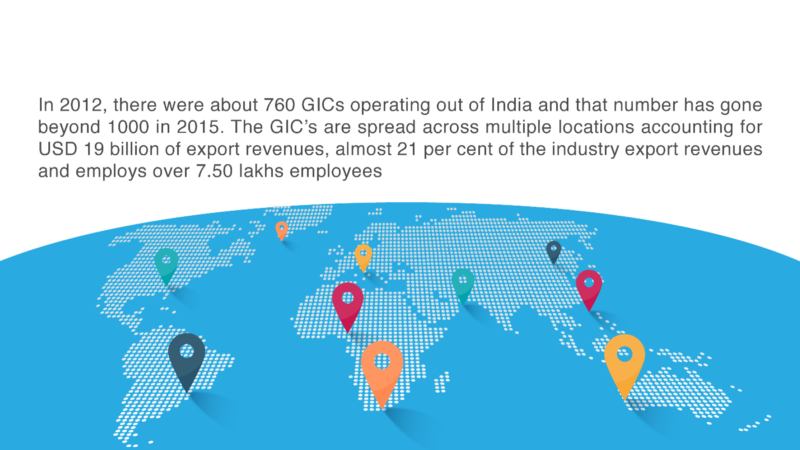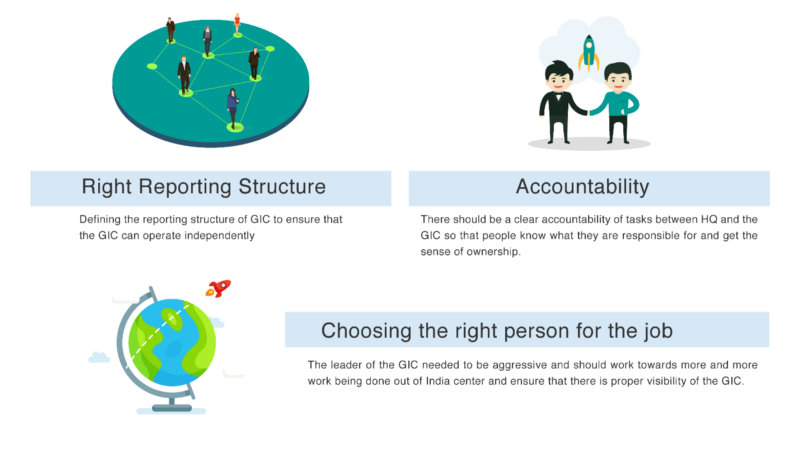|
|
Global In-house centers (GICs) are redefining the way businesses leverage diverse talent pools and skill sets distributed across geographies. With respect to the Indian use case, a low cost and highly skilled talent pool combined with a well-established IT Infrastructure, makes the region an ideal growth zone for GICs. It is no surprise that they are now an integral component of the fast-rising Indian IT-ITES sector. The following numbers provide an insight into just how fast this growth has been.

The Global Retail Giant, which currently spends well over $1billion on technology annually and has multi-million-dollar outsourcing contracts with TCS and Infosys, wanted to build up its own engineering capabilities internally and not rely solely on third party vendors.
One of the contributing factors that led to this decision was a major data breach in 2013 by the outsourcing organization. This led the retail giant to re-evaluate their dependency on external vendors and take significant steps towards developing capabilities in-house. Additionally, it made strategic sense to keep intellectual property within the organization and leverage it to drive innovations in line with the R&D Roadmap.
That said, the global leader in the retail industry was not inexperienced to the concept of GICs. In 2005, they decided to leverage the GIC model to cut costs and gain access to the growing talent pool in India.
What started as a 300-member team has now grown into a 2800+ strong workforce which primarily focuses on technology and innovation. The first center in Bangalore sourced most of its talent from Sapient (70%) and a significant portion in-house (30%).
The great start was not without its initial set of challenges. There was an urgent need to outline clear guidelines and set expectations from the outset to ensure a stable future. Some of the key questions raised were with regards to:
 Measures to ensure GIC success
Measures to ensure GIC success
The GIC story had just attained a satisfactory ending- one of being a stable, pure play cost center- when the Global Parent decided to alter the story line to accommodate excellence, innovation, and strategic intellect.
As operations stabilized and the GIC matured over the years, the presence of immense talent in growing technologies emerged. These technologies were “hot skills” in the market and were shaping the way businesses worked. The talent pool, sourced from technology giants like Amazon, Google, and start-ups like Flipkart, Snapdeal, propelled the GIC to a more strategic position and this did not escape the notice of the HQ. The Global Parent decided to restructure their operating models by transitioning greater number of responsibilities to the GIC.
During this process, however, the HQ observed a fundamental challenge at the GIC. Leaders and stakeholders predominantly spoke the technology language as they worked closely with technology and understood it well. A similar observation was that even though Product Managers working out of the GIC could effectively contribute to the requirements, they were not very aware of how the business worked and the challenges they faced, mainly because all the operations were based out of HQ.
The main takeaway from those observations was that GIC stakeholders would have to start speaking in the Business language which would enable them to play more of a strategic role than just a support role. This was made possible by ensuring that product teams regularly visited the HQ so that they can understand and talk the business language better.
As steps were being taken to empower the stakeholders, the GIC business was growing rapidly. The GIC was initially setup to complement the HQ with problem-solving capabilities in retail analytics, marketing, and technology. Over time, the stakeholders successfully positioned themselves to take ownership of many critical business functions- across a spectrum of digital technology, data sciences, merchandising, marketing, store design, and finance.
The best example of this transition is the Bangalore center’s strategic role in building an online retail site for the global business and maintaining it. The team in India started working on re-engineering the site’s search functionality and integrating analytics to enhance user experience.
In 2014, the GICs in question achieved sufficient operational stability that enabled them to look outward. They identified latent and significant potential in many start-ups that were disrupting the traditional Indian market place.
They developed an Accelerator Program, designed to attract and support early stage start-ups, and one of their first successful partnerships in this regard was with a wearable technology start-up.
The success of the partnership created a lot of buzz and excitement in the start-up space. Through a structured and well strategized model, the organization has now been able to mentor several successful ventures by giving them access to the right tools, resources and operational support.
While mentoring external talent, the HQ also kept a firm eye inwards. “A good business can create dependable workers but a great business can create inspirational leaders.” The HQ’s belief in this philosophy led them to work with their GICs to shape world class business leaders. Most of them have been pivotal in shaping and implementing the Global Parent’s core business values in India.
The key takeaway is that the scope of GICs can be pushed beyond a pure play cost center to an innovative hub that can potentially drive market expansion for the Global Parent.
The protagonists leading this change are constant strategic reinvention, astute investments in developing talent and infrastructure, and keeping an eye out for the next big thing.
Ultimately, it is a model that can be used by any big organization looking to leave a footprint in the diverse, global business landscape, leading to a holistic and sustainable growth that helps them move up the value chain.
Contributors : Manu Jain & Manu Srivastava contributed to this article.